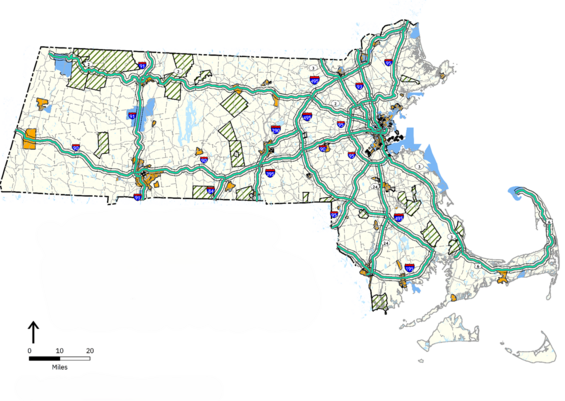11.0 Labor and Workforce Considerations
In compliance with 23 CFR 680.106(j) to ensure that the installation and maintenance of chargers is performed safely by a qualified and increasingly diverse workforce of licensed technicians and other laborers, all electricians installing, operating, or maintaining Electric Vehicle Supply Equipment must receive certification from the Electric Vehicle Infrastructure Training Program (EVITP) or a registered apprenticeship program for electricians that includes charger-specific training developed as part of a national guideline standard approved by the Department of Labor in consultation with the Department of Transportation, if and when such programs are approved. See Figure 3 for a map of all EVITP certified contractors within the state of Massachusetts. There is a total of sixty-one (61) EVITP certified contractors in the state, which are listed on the EVTIP website.
There have been two informational meetings with the International Brotherhood of Electrical Workers (IBEW) where representatives were informed of NEVI strategies and upcoming steps in deployment.
The Massachusetts Executive Office of Labor and Workforce Development (EOLWD) manages the Commonwealth’s workforce development and labor departments to ensure that workers, employers, and the unemployed have the tools and training needed to succeed in the Massachusetts economy. Within this office, the MassHire Department of Career Services oversees the Massachusetts network of MassHire Career Centers that assist businesses in finding qualified workers and providing job seekers with career guidance as well as referrals to jobs and training. The MassHire program includes 16 regional Workforce Boards and 29 Career Centers serving the needs of jobseekers and businesses throughout the Commonwealth. Massachusetts also has 148 secondary and postsecondary vocational and technical institutions, including 45 with electricity programs.
In addition, the Department of Higher Education (DHE) supports and coordinates economic and workforce development initiatives across Massachusetts' 29 public college and university campuses to align training, certificate, and degree programs with the workforce needs of the Commonwealth's growth and emerging industry sectors.
MassDOT will work with the selected industry partners to monitor the supply of workers with skills needed to support construction and maintenance of NEVI program DCFC infrastructure. If shortages are identified, MassDOT will consider the need to work with the EOLWD and DHE to identify programs that could be expanded or other training resources that might be needed to ensure an adequate workforce that supports timely construction and repair of NEVI program DCFC facilities.
Figure 3: EVITP Locations Overlaid on Disadvantaged Communities

Notes:
White: CEJST Disadvantaged Community
Blue Stripes: Limited English Proficiency (LEP)
Green Stripes: Travel Barriers*
Blue: 30-Year Flood Risk**
Yellow: Low Income***
Source: MassGIS, MassDOT, US Dept of Energy, USDOT CEJST, July 2024
*Census tracts with transportation barriers are equal to or above the 90th percentile for USDOT travel barriers, which take into account relative travel time, vehicle access, walkability, and travel cost.
**30-year flood risk census tracks are equal to or above the 90th percentile for share of properties at risk of flood in 30 years.
***Low income census tracts are equal to or above the 90th percentile for low median income and/ or poverty, and/ or are equal to or above the 65th percentile for household income less than or equal to twice the federal poverty level.